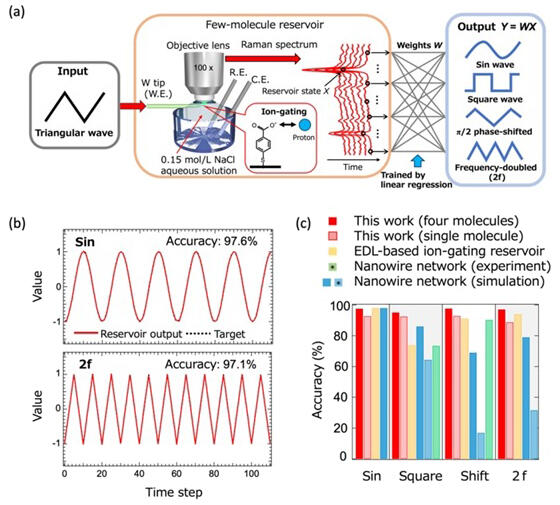A research team, led by Visiting Researcher Daiki Nishioka (Tokyo University of Science, JSPS Research Fellow), Principal Researcher Takashi Tsuchiya, and Senior Scientist with Special Missions Kazuya Terabe of the Ionic Devices Group, Research Center for Materials Nanoarchitectonics (MANA) at the National Institute for Materials Science (NIMS), has developed a new artificial intelligence (AI) device that performs brain-type information processing based on the molecular vibrations of a few organic molecules. This device afforded significantly higher prediction accuracy than similar AI devices in terms of predicting changes in blood glucose levels in diabetic patients. The results have been published in Science Advances.

(b) Results of the waveform transformation task using a sine wave and a frequency-doubled triangular wave (2f) as the target waveform.
(c) Comparison of the accuracy of the waveform transformation task with other physical reservoirs.
Provided by NIMS
As the industrial application of AI increases, power consumption is emerging as a major issue. One solution to this problem that is being researched is physical reservoir computing (RC), which uses physical phenomena occurring in materials and devices for brain-type information processing.
The research group demonstrated physical RC using the molecular vibrations of a few organic molecules in an experimental system. In a three-electrode electrochemical cell, the working electrode is composed of a tungsten (W) chip, and to the apex of this chip, an electrically conductive tungsten oxide (WOx) nanorod (rod-like materials with nanoscale diameter) with a silver-nanoparticle-modified surface is attached. Platinum is used in both the reference electrode and the counter electrode. Near the interface of WOx nanorods and the silver nanoparticles, there are enhancement sites exhibiting surface-enhanced Raman scattering (SERS). When the WOx nanorods are immersed in a 0.15 mol/L NaCl electrolyte aqueous solution containing 10 µmol/L p-mercaptobenzoic acid (pMBA) molecules, several pMBA molecules were adsorbed onto these enhancement sites. Normally, Raman scattering of only a few molecules is very weak and cannot be detected. However, in this study, Raman spectra of pMBA molecules were observed as they were enhanced by an order of magnitude due to the SERS effect. The information was input as a change in the chemical state of the pMBA molecule in terms of the change in the amount of hydrogen ions adsorbed in response to a change in local pH induced by the application of a voltage to the working electrode.
First, a typical benchmark test, viz., a waveform transformation, was performed. Triangular waveforms were input into the working electrode and the time evolution of the change in Raman spectra associated with the change in the chemical state of the pMBA molecule corresponding to the input waveforms was measured. By calculating the linear sum of the scattering intensity and output weight at a certain sampling wavenumber, nonlinearly transformed waveforms, including a sine wave, a square wave, a phase-shifted triangular wave, and a doubled wave (a triangular wave with a doubled frequency), were obtained. The transformation to sine wave and doubled wave was possible with high accuracy of greater than or equal to 97%.
Next, this method was used to predict changes in blood glucose levels in a diabetic patient. The blood glucose fluctuations of a type 1 diabetic patient over approximately 20 h were converted into voltage signals and were input into the working electrode for the purpose of training. The system was then used to predict subsequent changes in the patient's blood glucose levels. The predicted waveforms captured the characteristics of actual blood glucose changes well, and the prediction error obtained was approximately 50% lower than the champion data of previously known devices.
This research has resulted in the development of a new technology in which the molecular vibrations of a few organic molecules are made to work like a computer. Not only simple mathematical models, but also very complex changes in human blood glucose levels could be predicted using a few molecules. This suggests a new step towards the development of highly integrated and high-performance AI devices that leverage the properties of nanomaterials.
Journal Information
Publication: Science Advances
Title: Few- and single-molecule reservoir computing experimentally demonstrated with surface-enhanced Raman scattering and ion gating
DOI: 10.1126/sciadv.adk6438
This article has been translated by JST with permission from The Science News Ltd. (https://sci-news.co.jp/). Unauthorized reproduction of the article and photographs is prohibited.




